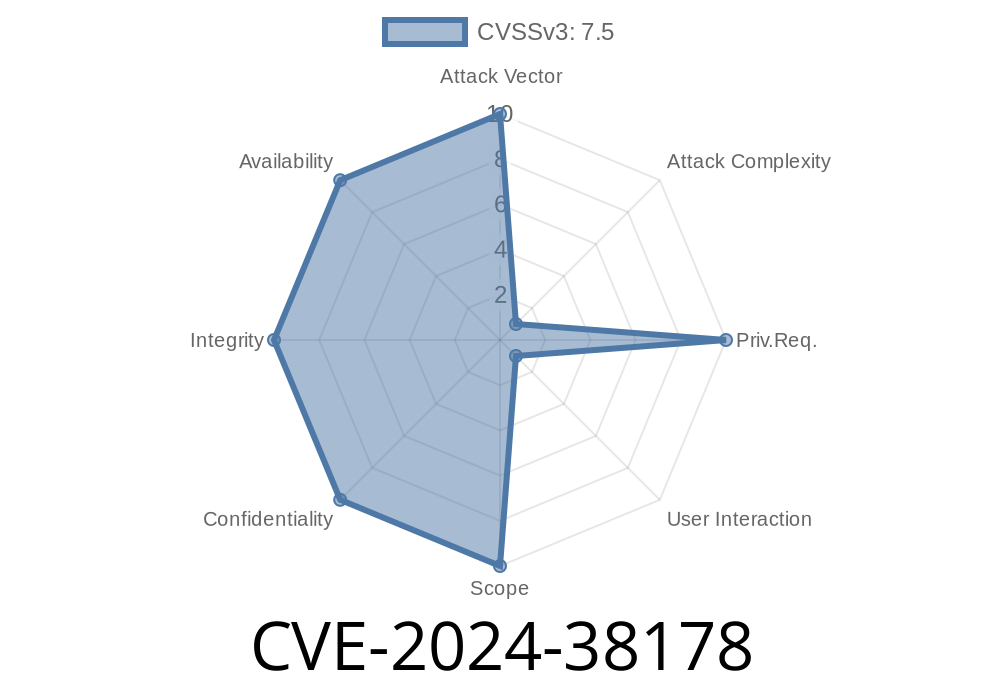*Please note: The vulnerabilities discussed in this post are for educational purposes only. Do not use this information to exploit the vulnerabilities or to perform any malicious activities.*
In this long read, we will dive into an extensive analysis of CVE-2024-38178, a memory corruption vulnerability within a scripting engine. We will outline the technical details, impact, and potential mitigation to provide a comprehensive understanding of the issue.
Introduction to CVE-2024-38178
CVE-2024-38178 is a memory corruption vulnerability in a scripting engine. This exists due to inappropriate handling of objects in memory. An attacker could exploit the vulnerability by executing specially crafted scripts to cause arbitrary code execution, potentially allowing them to compromise the system.
The affected scripting engine is widely used in web applications and browsers, which increases the potential attack surface. Therefore, understanding and mitigating this vulnerability is crucial for any organization that relies on web technologies.
For more thorough information, refer to the official CVE description and the National Vulnerability Database entry.
Technical Details of the Vulnerability
In order to understand the vulnerability, we first need to comprehend the underlying issue in the scripting engine's memory management. The vulnerability is triggered when specific functions, such as functionA, reference an object that is no longer valid. Let's break down a simple code snippet that demonstrates this problem:
1. var objA = new ObjectA();
2. var objB = new ObjectB(objA);
3. functionA(objB);
4. objA = undefined;
5. functionA(objB);
In this example, objB is created with a reference to objA. functionA is then called with objB as an argument. However, after making objA undefined, the same function is called again, using objB, which now refers to an invalid object. This leads to memory corruption.
The vulnerability can be exploited by an attacker via crafted scripts with improper handling of memory, which allows for arbitrary code execution.
Impact of the Exploit
An attacker who successfully exploits this vulnerability can execute arbitrary code in the context of the current user. If the current user is logged on with administrative privileges, the attacker could take complete control of the affected system.
There are several ways to mitigate this vulnerability
1. Patch management: The first and most important thing is to apply security updates provided by the vendor. To reduce the risk of exploitation, regularly check for updates to the affected software and install them once they are available.
2. User privileges: Restrict users' privileges to the minimum necessary, so even if the vulnerability is exploited, the damage will be limited.
3. Web browsing best practices: Educate users on safe browsing habits. While the vulnerability is in the engine itself, it can be exploited through web browsers running malicious scripts. Ensure users are cautious when visiting unknown websites and do not click on suspicious links.
4. Script blocking: Consider using browser extensions or third-party applications that block scripting languages, such as JavaScript, on unknown or untrusted websites.
Conclusion
CVE-2024-38178 is a serious memory corruption vulnerability affecting a widely-used scripting engine. Understanding the technical details, impact, and methods to mitigate this vulnerability is paramount for organizations relying on web technologies.
By staying vigilant, keeping software up-to-date, limiting user privileges, and following general web security best practices, you can significantly reduce the risk of falling victim to this and other similar exploits.
Timeline
Published on: 08/13/2024 18:15:26 UTC
Last modified on: 09/17/2024 23:33:04 UTC
